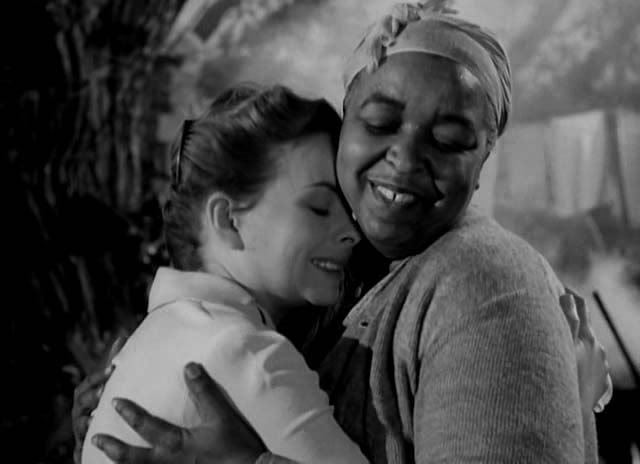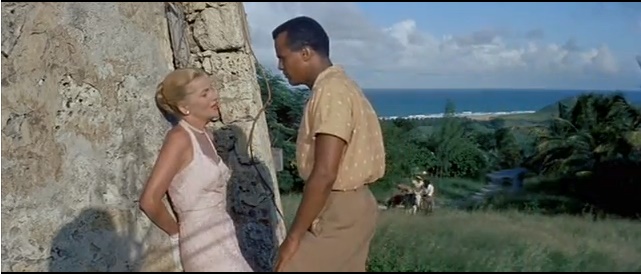This guest post by Hannah Graves appears as part of our theme week on Interracial Relationships.
Twentieth Century-Fox’s Pinky is far from the first Hollywood feature film that depicts an interracial relationship. Despite the evolution of various censorship codes that forbid depicting “miscegenation,” Hollywood has a rich history of mining the salacious or elicit potential from interracial pairing on screen, from Broken Blossoms to Duel in the Sun, Showboat to Imitation of Life. Yet, Pinky was quite distinct in tone from the films that came before it.
Produced by Fox’s studio chief Darryl F. Zanuck, Pinky was part of a spate of post-war social problem films that earnestly sought to address topical issues. Studios promoted these films as evidence that their medium was maturing, littering their advertising with exaggerated claims about the power of their pictures. As one of Pinky’s screenwriters, Phil Dunne, wrote in a New York Times article, “What we say and do on the screen in productions of this sort can affect the happiness, the living conditions, even the physical safety of millions of our fellow citizens.” Pinky is best understood at the starting point for a new Hollywood trajectory for interracial relationships onscreen: the worthy Oscar-bait drama that claims to enlighten as it entertains and serves as a conduit for fostering tolerance in the presumed white audience. It is a tradition that informs films from A Patch of Blue and Guess Who’s Coming to Dinner to Monster’s Ball and the forthcoming Loving.
Pinky is about the identity crisis of Patricia “Pinky” Johnson (Jeanne Crain), a light-skinned woman of ambiguous mixed-race ancestry who has been ‘passing’ as white at her northern nursing school. Set in the late 1940s, the film opens on Pinky as she returns to her southern hometown and grandmother, Dicey (Ethel Walters), after feeling a marriage proposal from Tom (William Lundigan), a white Northern Doctor. Back in the South, Pinky reencounters the racism of her hometown and finds herself the victim of police scrutiny and sexual assault. She resolves to leave but finds herself reluctantly nursing a local white matriarch, Miss Em (Ethel Barrynore), who lives in the nearby planation house. Both Miss Em and Dicey challenge Pinky about her passing, arguing she is not being true to her authentic self. When Tom returns, Pinky informs him about her racial heritage and he reiterates his proposal, albeit implicitly on the condition they live away from both of their families and she continue to pass. Finding herself the sole inheritor of Miss Em’s vast estate after Miss Em dies, Pinky successfully fights for her right to the property in court. She decides to reject Tom’s proposal and converts the planation into a clinic for the local African American community where she resolves to live. An unequivocal hit, Pinky was Fox’s top-grossing film of 1949 and its three lead actresses all received Oscar nominations.
I have something of a love/hate relationship with Pinky. Mixed-race and racially ambiguous looking myself, I have always been fascinated by stories of racial passing. In the scheme of things, life turns out pretty good in Pinky, even if the film lacks nuance. Of course, colorism undergirds the film’s efforts to make its contemporary white audience relate to Pinky. Yes, Zanuck cast a white actress as Pinky rather than Fredi Washington or Lena Horne, rightly drawing criticism in the African American press. It is extremely unfortunate that a cranky white matriarch successfully instructs Pinky on how she should racially identity according to the “one drop” rule, a element even The New York Times recognised as paternalistic. And yes, I know, Pinky and Tom don’t end up together and their relationship is unable to thrive, presumably like the unaddressed interracial relationship that resulted in Pinky herself. However, unlike some of her tragic predecessors, Pinky doesn’t drown in a lake, fall off a building, or fall into prostitution because of a doomed romance. Instead, she gets to keep a large piece of property and embarks on a fulfilling career doing desperately needed work, even if the clinic gets Miss Em’s name on it. This is a big deal. It is also very different from Pinky’s fate in the film’s source material.
According to records held at the Library of Congress, and analysed in Thomas Cripp’s Making Movies Black, the NAACP was understandably nervous when they heard Zanuck wanted to adapt Cid Ricketts Sumner’s novel, Quality (1946), for the big screen. Serialised in the Ladies Home Journal, Quality was an offensively pro-segregationist novel with several racist stereotypes. Not least of which was Pinky who, in true tragic mulatto fashion, suffers Tom’s rejection immediately after he discovers her heritage. Things don’t get much better for Pinky from there; vengeful white locals burn down the property she inherits at the novel’s close. Perhaps this darker ending more accurately reflected the realities of race relations in the pre-Loving vs. Virginia South of 1949, but it wasn’t the story Fox wanted to tell about America (or release internationally) during the Cold War.
In their quest to fashion a more uplifting look at American race relations, Fox’s successive screenwriters tried to salvage the material, but often fell back on familiar tropes. Perhaps recognising the limited perspectives of his white male writing staff, or maybe just feeling increasingly under-pressure from those he consulted at the NAACP, Zanuck recruited a young actress, Jane White, to advise on the script. Jane was the daughter of Walter White, the Executive Secretary of the NAACP. A Smith graduate, Jane found herself in a difficult position in her pursuit of theatre work: too light-skinned in appearance for the limited roles for Black women while racist hiring practices exempted her from consideration for white roles. Stuck in this limbo, she accepted the trip out West to consult on the Fox lot.
Working closely with Pinky’s second screenwriter, Phil Dunne, Jane revealed herself whip-smart, opinionated, forthright and funny. I have never had as good a time in an archive as I did at USC reading her notes chiding her male colleagues about their story’s failings. More is the pity that Fox failed to take up all of her suggestions; we might have had something really special if they did. However, Jane was able to make her colleagues see the limitations of the interracial relationship. She argued that Tom should not reject Pinky, as he did in Quality, but rather declare his loyalty to her. In the film, Tom admits that Pinky’s race poses “important problems” but decides they should “face them like rational people.” He explains that as a doctor and a scientist he does not believe “in the mythology of superior and inferior races.” While Pinky is unable, eventually, to accept his condition that they move out West to start their life together, he is very different from the brute of the book. In turn, Jane advocated for additional dialogue that would clarify for the audience how, at the end of the film, Pinky would be fine without this relationship developing. As Jane explained, Pinky’s life had a more important purpose than to be Tom’s wife and this needed to shine through. Ideally, Jane hoped that a young eligible Black man could wait in the wings to round off the love story. However, the limitations of mid-century interracial romance on screen came full circle: audiences and censors would not accept a white actress and a Black man embracing on screen, even if the actress played an African American character. The idea was scrapped. Although eight years later audiences got that embrace in another Zanuck production, Island in the Sun.
Pinky’s love story may seem mild now, but it is worth remembering its initial context; even the kiss between the two white actors who played Pinky and Tom was too controversial in some southern cities, prompting censorship and cuts. Pinky may offer a fairly cowardly white lover and a failed interracial relationship, but Jane White transformed a tragic mulatto story into a film where a heroine parts from her lover without tears to find emotional satisfaction in her professional accomplishments. This may be too chaste and self-sacrificing but it was a markedly better ending for a woman who passed and fell in love with a white man than those that came before and it laid some of the groundwork for depictions of interracial relationships that followed. In the midst of our current inclusion crisis in Hollywood, Jane White’s work serves as a reminder of what can happen when you get a seat at the table. She is why, whatever we might think about Pinky in the final analysis, it is worth remembering.
Hannah Graves is completing her Ph.D. in History at the University of Warwick. She is also the website editor and social media officer for the Women’s Film and Television History Network. You can find out more about her work here.





1 thought on “‘Pinky’ and the Origins of Interracial Oscar-Bait”
Comments are closed.